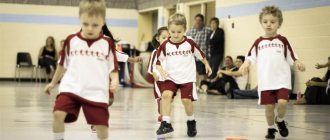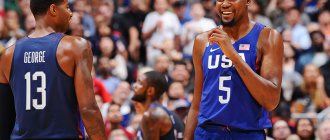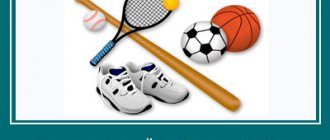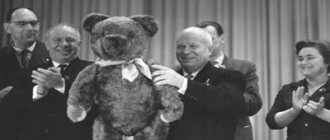Features of the most popular sports
Football .
The most popular and most sought-after sport among the broad masses of parents. No wonder - the accessibility to practicing and understanding this game is very high. However, there is also a purely practical side to the advisability of playing football. Sports methodologists note that football, especially in early childhood, develops coordination and accuracy of movements better than any other sport, and well forms a child’s motor skills - and this applies not only to boys, but also to girls. Experiments conducted in secondary schools have convincingly proven the positive impact of football on the physical education of children.
In particular, even girls who were behind their peers in development, after six months of playing football, no longer had difficulty mastering the physical education program, and even moreover, they began to outperform “ordinary” girls. And there’s nothing to say about the boys - they always play ball with pleasure and interest.
If you want to teach your child football, then first of all decide what level of lessons is suitable for you. Take a closer look at how the child moves during walks: he simply runs, kicking the ball, or tries to work with the ball and change directions of movement. Football abilities at this age are not easy to notice, but some inclinations are still visible. In particular, if a boy during the game tries to quickly get rid of the ball, trying to hit it away from himself - this fact is not in favor of a football future, but if he values the ball and tries to communicate more with it, you can think about developing football skills.
Something special needs to be said about choosing a training location: don’t get hung up on the loud signs of football schools. The insane competition and psychological pressure under which a child exists in so-called “elite” schools often permanently discourages a boy from studying at an early age. Many promising guys are lost for football at this stage.
Therefore, the best choice for starting is a small football school near your home. And let the boy train in a good mood - this is important! In the future, if the guy represents something, he will still end up in a more serious team.
Martial arts . A very popular desire among parents is to make their child strong, learn to fight back and not be afraid of anything. In this regard, training in various martial arts is seen by many as a universal means for developing the listed qualities.
There are martial arts based on striking techniques - boxing, karate, kung fu, etc., and there are types based on strength and dexterity - various types of wrestling. Of course, in all martial arts there are a lot of details unique to each type - psychological, philosophical, intellectual and social. This is the subject of a special discussion, and we will start with the simplest.
Martial arts have gained particular popularity in recent decades. This includes judo, sambo, karate, taekwondo, aikido, wushu and many other martial arts options. These sports develop coordination of movements, muscles, teach the baby to react quickly and fall correctly.
Girls practice martial arts no less willingly than boys. This is not surprising: in our time, the ability to stand up for yourself is a very useful skill. The level of injury in qualified teaching is not higher than usual. However, you must be prepared for the fact that bruises are inevitable after training.
Wrestling is a wonderful sport from the point of view of cultivating true perseverance and fortitude. Wrestling coaches note that, unlike football, where for high achievements you need to be “kissed by God,” wrestling does not require special talent. You need character. And if he does, the guy will fight.
However, you shouldn’t rush headlong into sending your child to the wrestling section. This sport cannot be rushed, and 6–8 years old is definitely not the age when “it’s time to start.” Trainers recommend the following scheme: to begin with, swimming (to develop breathing and bring muscles into proper tone), then for a year or two, practice team sports such as football or basketball (to develop coordination and primary endurance), and only at 11–12 years old come to the wrestling room. This is how potential champions start. A similar algorithm is recommended for young boxers. Boxing is not for small children, it should be memorized like two and two.
Now about martial arts. Boys who have seen enough action films with the participation of Jackie Chan and Jean-Claude Van Damme should remember that he will become like this, and even better, if he does not force the development of events. Judo, karate, kung fu and taekwondo in childhood are not fighting, but rather gymnastics. They move on to the fighting technique as such in these types later. There are, however, exceptions to this rule: some karate schools teach striking techniques “from a young age.”
But think about it, do you need it? It should be remembered that martial arts is a special lifestyle in which the coach (aka sensei, teacher, etc.) is the king and god, the unquestioned authority, and “falling at his feet” is a completely natural thing; The child’s individuality in this case is secondary.
If you go to the same karate section at the age of primary school, you risk getting a certain mental breakdown, which in the future can put an end to sports altogether. Therefore, if you are interested in flexibility and dexterity (and this is what “easterners” mainly do with children at first), then it is recommended to take a closer look at the gymnastics and acrobatics sections or simply general physical training. You will still have time to return to the art of combat.
Tennis . A very fashionable and also specific sport in its own way. Its nuances are a topic for another discussion. But in general, this game is a universal tool for raising a harmoniously developed and active child. Don’t be surprised – we recommend tennis primarily for girls at an early age. They “grasp” the essence of training exercises better, begin to enjoy the process faster and, accordingly, begin to progress quite quickly.
With boys it's different. If you want to raise a tennis player, it’s better to start... with football. It is common knowledge that football players make excellent tennis players. Football brings the desired tone to the legs and improves reaction. Legs are the foundation of a good tennis game. Classic tennis training for boys often turns out to be boring at first, but after switching from another game, the impressions change.
Football is the best “tutor” for your upcoming tennis career. Basketball and volleyball are also good. And also, some coaches claim that to play tennis well, it is useful to play... chess. Game thinking is similar. Do you believe it?
Be sure to consider the child's character. Tennis is an individual sport, but if your child is a strong individualist, do not lose sight of the fact that the first time in tennis sections, children in any case practice in groups. And therefore, the ability to get along with others, the ability to analyze other people’s mistakes and notice the useful qualities of comrades will also have to be developed.
During classes, almost all muscle groups work, coordination of movements develops well.
This sport (or rather, regular competitions) also helps to develop in a child qualities that are so necessary in life, such as perseverance and perseverance. However, to be honest, this sport is not cheap. In addition, tennis cannot be neglected. To seriously master the technique, you need to practice 2-3 times a week, and the number of children in the group should be no more than 4-5. Individual training is also necessary from time to time. Figure skating .
A traditionally popular sport in our area. Beautiful, aesthetic, romantic, and at the same time complex, strong-willed, traumatic. Parents often send their children to figure skating due to rather prosaic circumstances - on the recommendations of doctors. Children who often suffer from colds in early childhood, as practice shows, cope very successfully with their problem as a result of training on ice - the body is hardened. Therefore, choosing figure skating is also a type of prevention of ARVI. Is it recommended for everyone? Not at all. Recruitment for figure skating schools starts from 4–5 years of age. At this age, in order to be selected for a group for classes, it is necessary to show the rudiments of plasticity, choreographic abilities, flexibility and, most “terribly”, the ability to listen to the coach. What follows from this? That figure skating at an early stage is almost exclusively a “girls’” sport.
Girls who develop faster than the stronger sex at the age of five, by this time already demonstrate remarkable abilities in dance movements and the ability to repeat them after the teacher. Most of the boys who come to the “selection” are either outright idiots or too young to understand the essence of what is happening.
Therefore, take your time and try to predict the “correct” time to start practicing this difficult sport. And most importantly, if your child clearly does not shine with mobility and coordination, do not despair: there are other sports that will definitely suit him. And we'll talk about this later.
From childhood, parents strive to develop their child. Moreover, more and more often, mothers and fathers give preference to spiritual and intellectual development, relegating physical activities to the background. But don’t underestimate the importance of physical fitness!
American doctors, concerned about the rapid “rejuvenation” of cardiovascular diseases, conducted large-scale studies among children and adolescents. The result was impressive. It turned out that the age from 5 to 8 years is decisive in terms of the risk of developing atherosclerosis and myocardial infarction in an adult. Moreover, the more active the child was in sports, the lower this risk.
Scientists provide several more compelling reasons in favor of regular exercise:
- 30% of preschoolers are already experiencing changes in posture (and in the first years of school this figure increases to 65%!);
- more than 30% of children weigh more than they should. But it is known that childhood obesity is very difficult to overcome;
- from 20 to 25% of children already have circulatory disorders such as vegetative-vascular dystonia;
- 40% of children regularly complain of back pain.
It is clear that every parent wants their child to grow up healthy and strong. So, it was decided: we need to play sports! But which one exactly? In search of a solution to this problem, mothers and fathers, unfortunately, often take the wrong path. And all due to the fact that often the interests and capabilities of the baby remain in the background, and parental ambitions come forward.
Summer is a great time to start preparing your child for sports. You shouldn’t rack your brains over which sports school is the best in your city: your friends will most likely tell you this, or after studying newspapers or Internet sites, you yourself will make the final verdict. The main problem is of a different kind: which sport to choose. The sports traditions in our country are quite deep, and now, fortunately, the fashion for a healthy lifestyle is gradually establishing itself in our country. So the choice of sports sections, schools and clubs is quite large.
Team games. This option is best suited for open-minded, sociable children. Or, conversely, for kids who need to develop this character trait. We will not stop to list all the types. It is only worth noting, perhaps, that although no one has abolished the concept of sports equality in the field of team sports, there are nevertheless certain restrictions for representatives of the fairer sex.
Girls are usually recommended to try their hand at basketball, handball, and volleyball, but most parents, even those who are passionate about this sport, consider it inadvisable to send their baby to, for example, women’s hockey. Many boys enjoy playing football or throwing a ball into a basketball hoop. So, if you don't have clear priorities among sports, it might be worth starting with these. Professional training usually begins at age 5. As a rule, boys like a lot of movement and communication, and besides, football, like hockey, is “played by real men” in our country.
Water sports. Without exaggeration, this element suits everyone. Children who have not yet learned to walk learn the basics of sports here. Parents themselves, when sending their child to swimming, diving or water polo, often justify their decision by saying that it is thanks to sports water procedures that children develop good posture and strong muscles. And the very fact that the child will learn to swim and feel like a fish in water does not leave many parents indifferent. What can we say about the role of hardening!
Gymnastics . It can become the first step in practicing any other sport (it’s not for nothing that it is called the mother of all sports), and you can start training as early as 3 years old. This sport develops almost everything: posture, coordination, muscles, character, grace. Gymnastics is especially loved and popular among girls.
There are many reasons for this. And one of them is due to the fact that the figure of a gymnast looks the most harmonious: girls do not have the broad shoulders inherent in those who engage in water sports, and there are no sharp, angular movements that characterize participants in team sports. In addition, the flexibility developed during classes remains with the girl for the rest of her life, giving her gait lightness and grace.
Skis . These are not only traditional skis, but also the now fashionable biathlon, snowboarding, ski jumping, alpine skiing and much more. However, experts strongly recommend that children begin their acquaintance with winter sports with traditional skis. This sport is especially good from the point of view of hardening, because the child gradually gets used to constant fresh air, all muscles (primarily the legs) and coordination of movements develop. Of course, there is a risk of injury. But there is no absolutely safe sport. Sport is sport. You shouldn't forget about this.
Dancing . Want to find an easier and safer way to introduce your child to sports? Start with regular dancing. This is useful primarily for general development. Dances include: sports and folk, aerobics, all kinds of modern dances. Who knows, maybe this is your child’s calling?
Sport is the key to health.ppt – Presentation “Sport is the key to health”
Municipal budgetary educational institution Educational boarding school No. 1 of Basic General Education in Tomsk Research work “Sport is the key to health” The work was completed by: student of the 6th “B” class Oleg Tokarev Supervisor: Belyaeva Irina Ivanovna, Class teacher/teacher of the 6th “B” class of 2016.
Why did we choose this topic? In our work, we want to prove that playing sports helps us: • study better, • make friends, • broaden our horizons, • manage our time correctly.
The purpose of our research: to attract the attention of our friends, classmates, and acquaintances to the need to regularly attend sections. Subject of the study: children’s attitude to sports and regular attendance of sections. Objectives: •Study the theoretical part of this issue; •Conduct a survey of students on this issue; •To study the attitude of children to sports among boarding school students; •Analyze children’s attitudes towards sports; •Formulate recommendations and conclusions. Hypothesis: We assume that sport plays an important role not only for the physical development of the child, but also for the formation of the child’s mental and moral qualities.
See also: When to print a dismissal order
In the process of work we used the following methods:
•Theoretical information on the Internet). (literature study, •Empirical (conversation, survey). •Methods of statistical processing of results.
What is sport? The word “sport” was born a long time ago in France. And it was pronounced not as it is now, but “deport”, which means “entertainment”, “care”. and then they discarded the first two. In England they began to pronounce this word in their own way: “dysport”, letters. It turned out to be “sport”. More than 100 years ago, the word “sport” came to Russia. At first, sports in Russia included collecting stamps, playing dominoes, raising pets, and handicrafts. Later, only such physical exercises that help improve health make a person strong, courageous, dexterous and resilient.
Questionnaire questions: 30 people, students of 6 grades (3 grades - 6 “A”, 6 “B”, and 6 “C”) of boarding school No. 1, took part in our study. Children were asked to fill out questionnaires, marking their answers to the questions on a specially prepared form. • Do you go in for sports: Yes – 23 people (77%); No – 7 people (23%). • Like to play sports: Yes – 25 people (83%); No – 5 people (17%). • As a result of our survey, it was revealed that 77% go in for sports and 83% like sports. • There were even some guys who don’t play sports (23%), and they don’t even like it (17%).
Research on children's interest in sports
Results: Only 14 30 people from Iz systematically participate in sports sections, and 1 person goes to the gym (50%). Moreover, 5 of them are engaged in several sections. This is swimming - 10 people, boxing - 1 person, sports dancing - 1 person, skiing - 2 people, judo - 2 people, gymnastics - 1 person, hand-to-hand combat - 3 people, gym - 1 person. Swimming is the most popular!
Sports in the life of a schoolchild Physically active children do better in school than those who move little
Boxing is my school of life
Boxing is my school of life
A set of physical exercises at school and at home for my classmates who do not attend any sections • 1. Walking. Step from the right foot - clap your hands forward, step from the left foot - clap your hands behind your back. Within 30 seconds. • 2. I. p. - standing, legs apart, hands clenched into fists. On count 1 - turn your torso to the right, spread your arms to the sides, jerk them back, while vigorously unclenching your fingers; on the count of 2 - return to i, p. On the count of 3-4 - the same in the other direction. Do not move your legs. Repeat 6-8 times. • 3. I. p. - standing, legs together, arms down. Circular movements with straight arms forward. Then move your arms backwards in a circular motion. Repeat 12-16 times. • 4. I. p.—sitting astride a chair, hands on the belt. On the count of 1-2, leaning to the side, touch the floor with your hand as far as possible from the chair; on the count of 3-4 - return to i. n. The same thing in the other direction. Repeat 4-6 times. Breathing is voluntary. • 5. I. p. - standing “in a line” (toe of the right foot to the heel of the left), arms down. On count 1 - rise on your toes, arms to the sides - inhale, on count 2 - 4, squat down (without falling on your heels), turn to the right and lower your arms down - exhale. Do the same, placing the toe of your left foot against the heel of your right foot. Repeat 4-6 times. • 6. I. p. - sitting on the floor, legs wider than shoulders, hands to shoulders. On the count of 1, moving your shoulders back, bend over - inhale; on count 2—lean forward, turning your torso to the right, touch the floor in front of you with your left elbow—exhale; on the count of 2—return to i. n.—inhale. On the count of 3-4, do the same in the other direction. Do not bend your knees. Repeat 6 times. • 7. I. p. - lying on your back, hands on the floor along the body. On the count of 1-2—raising your straight legs up, touch your toes to the floor behind your head; on the count of 3-4 - return to i. n. Breathing is voluntary. Repeat 4-6 times. • 8. I. p. - standing, legs together, hands on the belt. Jumping on two legs, with turns. On the count of 1-3—jump on your toes in place; on the count of 4—turn 90 degrees. Breathing is voluntary. Within 30-40 seconds. • 9. Walk with vigorous arm swings for 1 minute. Breathing is voluntary.
Conclusion: Sports are not a hindrance to studies. On the contrary, the more we move and engage in active sports, the more actively we grow and the better the brain develops, therefore sport has a positive effect on: • academic performance; • disciplines a person in his studies; • sport plays an important role not only for the physical development of a student, but also for the formation of personality.
List of used literature by games:
1. Azarova R.I. Leisure of modern youth // Out-of-school student. – No. 10. 2003. 2. Apletaev M.N. System of personality education in the learning process. Omsk: Publishing house of Omsk State Pedagogical University, 1998. 3. Arkhangelsky N.V. Values and education // No. 4 M.: Pedagogy, 1999. 4. Babansky Yu.K. Pedagogy: Course of lectures M.: Education, 1997. 5. Vinogradova N.D. Moral-volitional qualities of the individual. M., 1997. 6. Gordeeva A.V. Passion is a psychological aspect. – K. – 2004. 7. Kukshin V.S. Theory and methodology of educational work: Textbook. Ed. 2e, rev. and additional – M.: ICC “Mart”, Rostov – n/a: Publishing House, 2004. 8. Malkin V.R. “Department of psychological training in sports” 2008 9. Platov Anton. Children, network and parents. World of Computers No. 3. – 2004. 10. Sedova L.N. Theory and methods of education. Lecture notes / L.N. Sedova, N.P., Tostolutskikh. – M.: Higher Education, 2006. computer
Other publications:
- Petition for Divorce Can you file for divorce by mail? I don’t want to go to the defendant’s location. Is it possible to file for divorce by mail without appearing in court yourself, or through a representative? There are no minor children, the issue of division of property is not [...]
- I ask you to ensure a safe stay in the group for my child. SAMPLE APPLICATIONS Algorithm of actions to protect the rights of your child to kindergarten. 1. After you have been verbally denied a ticket to a kindergarten, you must request a written refusal from the education department. You can personally at the reception in office 9 [...]
- Notary Belarusian Baranova Notary Baranova O.N. Address: 125040, Moscow, Leningradsky Prospekt, 9 Telephone: +7 (499) 2574736 Opening hours: Mon, Tue, Wed, Thu, Fri, Sat, from 9.00 to 18.00, lunch from 13.00 to 14.00 The notary provides everything services in Moscow related to notary […]
- Agreement for a copy of a product Agreement for a copy of a product S‹РІ сфере закупок RћСЂРіР°РЅРёР ·Р°С†РёСЏ, оказывающая SѓСЃР»СѓРіРё RїРѕ RѕР±СЃР»СѓР¶РёРІР°РЅРёСЋ RїРѕР»СЊР·РѕРІР°С‚Р µР»РµР№ […]
- A manual for a plumber A manual for a plumber The book outlines general ideas about the sanitary systems of buildings and structures, and also examines all stages of the production process of their construction: preparatory, procurement, assembly and […]
- Order 882n dated 1411-2019 Order of the Ministry of Labor and Social Protection of the Russian Federation dated November 14, 2014 No. 882n “On approval of the specifics of conducting a special assessment of working conditions at the workplaces of workers, the list of professions and positions of which is approved by the Government Resolution […]
What determines achievements in sports?
Factors influencing the dynamics of sports achievements in sports:
- Individual talent of an athlete. These are his inclinations, talents and abilities. Practicing any sport requires a person to demonstrate certain abilities, which are expressed by individual personality characteristics, which are a condition for the successful performance of one or more types of activity.
- The degree of preparedness for sports achievement. The coach tries to achieve the necessary development of the athlete’s abilities to ensure progress in the chosen sport. Currently, training loads and total time spent in the process of training athletes reach significant values. All this places high demands on the mental qualities and personality traits of an athlete.
- Efficiency of the athlete's training system. An important point in increasing the effectiveness of the training system for athletes is improving their tactical and technical training.
- The scope of the sports movement and its provision with personnel. The more people are involved in sports, the more athletes enter the big sport, and this, in turn, increases the competitiveness among them and is reflected in sports results.







